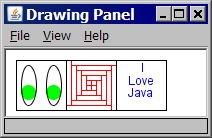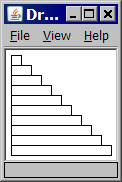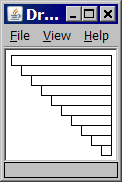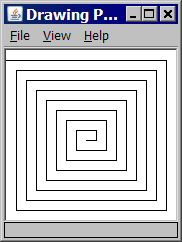University of Washington, CSE 142
Lab 3: Graphics, return, if/else, and Scanner
Except where otherwise noted, the contents of this document are Copyright 2011 Stuart Reges and Marty Stepp.
lab document created by Marty Stepp, Stuart Reges, and Whitaker Brand
Basic lab instructions
- We encourage you to talk to your classmates for help. You can even work on the lab with a partner if you like.
- You may want to bring your textbook to future labs to look up syntax and examples.
- Stuck? Confused? Have a question? Ask a TA for help, or look at the book or past lecture slides.
- You probably won't finish all of the exercises. Just do as much as you can within the allotted time. You don't need to keep working on these exercises after you leave the lab.
- Before you leave today, make sure to check in with one of the TAs in the lab to get credit for your work.
Today's lab
Goals for today:
- use the instructor-provided
DrawingPaneland Java'sGraphicsandColorclasses - use
returnvalues to send data between methods - use
Scannerto create interactive programs that read user input - Where you see this icon, you can click it to check the problem in Practice-It!

Exercise : Check MyUW scores
- The scores you receive on homework and labs are available for you to view in MyUW. Follow the instructions on our MyUW page to check your scores.
- You should see scores for labs 1 and 2. If not, contact your TA or a TA from your lab period.
- Using the information on your MyUW page, fill in the values below.
| class mean for a1 (i.e., average score for assignment 1) | / 10 |
8.86 |
| class mean for lab1 (i.e., average score for lab 1 homework) | / 1 |
0.97 |
Graphics
Now we'll explore several exercises related to drawing graphics.


-
We'll use a provided class
DrawingPanelthat works with Java classesGraphics(a "pen" for drawing) andColor. -
Download
DrawingPanel.javato your program directory. -
To check your output in the
DrawingPanel, click File, Compare to URL....
Exercise : Stairs loop table

Consider the output at right. The first stair's top-left corner is at position (5, 5). The first stair is 10x10 px in size. Each stair is 10px wider than the one above it.
Fill in the table below with the coordinates and sizes of the first five stairs. Note which values change and which ones stay the same.
| stair | x | y | width | height |
|---|---|---|---|---|
1
|
5 |
5 |
10 |
10 |
2
|
5 |
15 |
20 |
10 |
3
|
5 |
25 |
30 |
10 |
4
|
5 |
35 |
40 |
10 |
5
|
5 |
45 |
50 |
10 |
Exercise : Stairs


Write a complete Java program to draw the stairs. Copy/paste the code template below into jGRASP and fill in your own expressions or values for each stair's x, y, width, and height.
Use your table from the previous slide to help you find the correct expressions.
The values that change for each stair should become expressions in terms of the loop counter variable, i.
import java.awt.*;
public class Stairs1 {
public static void main(String[] args) {
DrawingPanel panel = new DrawingPanel(110, 110);
Graphics g = panel.getGraphics();
for (int i = 0; i < 10; i++) {
g.drawRect(x, y, width, height);
}
}
}
Exercise : Stairs 2

Modify your stairs program to draw one (or all) of the following outputs.
Modify only the body in your for loop.
(You may want to make a new table to find the expressions for x, y, width, and height.)
 →
→



Exercise - answer
To get each output, change the for loop body to the following:
// output 2
g.drawRect(5, 5 + 10*i, 100 - 10*i, 10);
// output 3
g.drawRect(95 - 10*i, 5 + 10*i, 10 + 10*i, 10);
// output 4
g.drawRect(5 + 10*i, 5 + 10*i, 100 - 10*i, 10);
Parameterized methods and Graphics
When you want to divide a graphical program into multiple drawing methods, you must pass Graphics g as a parameter in addition to any other parameters. Example:
public static void main(String[] args) {
DrawingPanel panel = new DrawingPanel(400, 300);
Graphics g = panel.getGraphics();
...
drawStuff(g, 13, 52, 7);
}
public static void drawStuff(Graphics g, int a, int b, int c) {
g.drawLine(a, 45, b, c);
...
}
Exercise : Face 1+2

Suppose you have an existing program that draws the "face" figure at right. Let's modify the program using methods and parameters so that we can draw several faces at different locations.
continued on the next slide...
Exercise : Face 2

Modify the Face program to draw the following output.
Write a parameterized method that draws a face at different positions.

- window size: 320 x 180 px
- faces' top-left corners at (10, 30) and (150, 50)
Exercise - answer
import java.awt.*;
public class Face2 {
public static void main(String[] args) {
DrawingPanel panel = new DrawingPanel(320, 180);
Graphics g = panel.getGraphics();
drawFace(g, 10, 30);
drawFace(g, 150, 50);
}
public static void drawFace(Graphics g, int x, int y) {
g.setColor(Color.BLACK);
g.drawOval(x, y, 100, 100);
g.setColor(Color.BLUE);
g.fillOval(x + 20, y + 30, 20, 20);
g.fillOval(x + 60, y + 30, 20, 20);
g.setColor(Color.RED);
g.drawLine(x + 30, y + 70, x + 70, y + 70);
}
}
Exercise : Face 3

Modify your previous Java program to draw the following output.
Use a for loop with your parameterized method to draw faces at different positions.

- window size: 520 x 180 px
- faces' top-left at (10, 30), (110, 30), (210, 30), (310, 30), and (410, 30)
Exercise - answer
import java.awt.*;
public class Face3 {
public static void main(String[] args) {
DrawingPanel panel = new DrawingPanel(520, 180);
Graphics g = panel.getGraphics();
for (int i = 0; i < 5; i++) {
drawFace(g, 10 + i * 100, 30);
}
}
public static void drawFace(Graphics g, int x, int y) {
g.setColor(Color.BLACK);
g.drawOval(x, y, 100, 100);
g.setColor(Color.BLUE);
g.fillOval(x + 20, y + 30, 20, 20);
g.fillOval(x + 60, y + 30, 20, 20);
g.setColor(Color.RED);
g.drawLine(x + 30, y + 70, x + 70, y + 70);
}
}
Returning Values
A return value is when a method sends a value back to the code that called it.
public static type name(parameters) { // declare
...
return expression;
}
variableName = methodName(parameters); // call
Example:
public static double fToC(double tempF) {
return (tempF - 32) * 5.0 / 9.0;
}
...
double bodyTemp = fToC(98.6); // bodyTemp stores 37.0
double freezing = fToC(32); // freezing stores 0.0
Math expression syntax
| Method | Description | Example |
|---|---|---|
Math.abs
|
absolute value |
Math.abs(-308) returns 308
|
Math.ceil
|
ceiling (rounds upward) |
Math.ceil(2.13) returns 3.0
|
Math.floor
|
floor (rounds downward) |
Math.floor(2.93) returns 2.0
|
Math.max
|
max of two values |
Math.max(45, 207) returns 207
|
Math.min
|
min of two values |
Math.min(3.8, 2.75) returns 2.75
|
Math.pow
|
power |
Math.pow(3, 4) returns 81.0
|
Math.round
|
round to nearest integer |
Math.round(2.718) returns 3
|
Math.sqrt
|
square root |
Math.sqrt(81) returns 9.0
|
Exercise - Math expressions
Write the results of each expression.
Use the proper type (such as .0 for a double).
Note that a variable's value changes only if you re-assign it using the = operator.
double grade = 2.7; Math.round(grade); // grade = 2.7 grade = Math.round(grade); // grade = 3.0 double min = Math.min(grade, Math.floor(2.9)); // min = 2.0 double x = Math.pow(2, 4); // x = 16.0 x = Math.sqrt(64); // x = 8.0 int count = 25; Math.sqrt(count); // count = 25 count = (int) Math.sqrt(count); // count = 5 int a = Math.abs(Math.min(-1, -3)); // a = 3
Exercise : area

Consider the following method for converting milliseconds into days:
// converts milliseconds to days
public static double toDays(double millis) {
return millis / 1000.0 / 60.0 / 60.0 / 24.0;
}
Write a similar method named area that takes as a parameter the radius of a circle and that returns the area of the circle.
For example, the call area(2.0) should return 12.566370614359172.
Recall that area can be computed as π times the radius squared and that Java has a constant called Math.PI.
- (Try solving this problem in Practice-It by clicking the icon above.)
Exercise : pay

Write a method named pay that accepts two parameters: a real number for a TA's salary, and an integer for the number of hours the TA worked this week.
The method should return how much money to pay the TA.
For example, the call pay(5.50, 6) should return 33.0.
The TA should receive "overtime" pay of 1 ½ normal salary for any hours above 8.
For example, the call pay(4.00, 11) should return (4.00 * 8) + (6.00 * 3) or 50.0.
- (Try solving this problem in Practice-It by clicking the icon above.)
User input and Scanner
| Method name | Description |
|---|---|
nextInt()
|
reads and returns the next token as an int, if possible
|
nextDouble()
|
reads and returns the next token as double, if possible
|
next()
|
reads and returns a single word as a String
|
nextLine()
|
reads and returns an entire line as a String
|
Example:
import java.util.*; // so you can use Scanner
...
Scanner console = new Scanner(System.in);
System.out.print("How old are you? "); // prompt
int age = console.nextInt();
System.out.println("You typed " + age);
Exercise : Scanner
Copy and paste the following code into jGrasp.
public class SumNumbers {
public static void main(String[] args) {
int low = 1;
int high = 1000;
int sum = 0;
for (int i = low; i <= high; i++) {
sum += i;
}
System.out.println("sum = " + sum);
}
}
continued on next slide...
Exercise :
Scanner
Modify the code to use a Scanner to prompt
the user for the values of low and high. Below
is a sample execution in which the user asks for the same values as in the
original program (1 through 1000):
low? 1 high? 1000 sum = 500500
Below is an execution with different values for low
and high:
low? 300 high? 5297 sum = 13986903
You should exactly reproduce this format.
Exercise : Spiral


Write a Java program that draws the following output using a for loop.
- window size: 170 x 170 px
- "spiral" lines starting from (0, 10), going right 160, down 150, left 150, up 140, right 140, down 130, left 130, up 120, ...
Exercise - answer
import java.awt.*;
public class Spiral {
public static void main(String[] args) {
DrawingPanel panel = new DrawingPanel(170, 170);
Graphics g = panel.getGraphics();
for (int i = 0; i < 8; i++) {
g.drawLine( 10*i, 10 + 10*i, 160 - 10*i, 10 + 10*i); // top
g.drawLine(160 - 10*i, 10 + 10*i, 160 - 10*i, 160 - 10*i); // right
g.drawLine( 10 + 10*i, 160 - 10*i, 160 - 10*i, 160 - 10*i); // bottom
g.drawLine( 10 + 10*i, 20 + 10*i, 10 + 10*i, 160 - 10*i); // left
}
}
}
Exercise - answer, alternative version
import java.awt.*;
public class Spiral {
public static void main(String[] args) {
DrawingPanel panel = new DrawingPanel(170, 170);
Graphics g = panel.getGraphics();
int x = 0, y = 10;
int len = 160;
for (int i = 0; i < 8; i++) {
g.drawLine(x, y, x + len, y); // right
x = x + len;
len = len - 10;
g.drawLine(x, y, x, y + len); // down
y = y + len;
g.drawLine(x, y, x - len, y); // left
x = x - len;
len = len - 10;
g.drawLine(x, y, x, y - len); // up
y = y - len;
}
}
}
If you finish them all...
If you finish all the exercises, try out our Practice-It web tool. It lets you solve Java problems from our Building Java Programs textbook.
You can view an exercise, type a solution, and submit it to see if you have solved it correctly.
Choose some problems from the book and try to solve them!